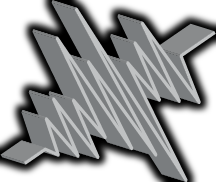Everything is geared nowadays for communicating over the internet and mobile devices. The most common format for music is the MP3 file (although it has officially been abandoned by its creators). It is still universally used and is great for sending in an email and it sounds pretty good. But there are some things that you should be aware of.
Audio is similar to pictures and video in that it uses small bits of data to trick us into thinking we are experiencing the real thing.
- Movies are nothing more than still images that are projected one after the other at about 30 images per second, which fool our lazy eyes into thinking we are seeing motion. Dogs, however, are not fooled.
- Digital images are nothing more than colored pixels crammed tightly together so that it fools our eyes into thinking we are seeing continuous colors.
- By the same token, digital CD quality audio is slices of time that are sent at 44,100 slices per second and fools our ears into thinking we are hearing continuous sound.
When we are creating in the studio, I am recording, mixing, and mastering with this kind of large data. One minute of a stereo CD quality WAV file is around 10 megabytes in size. A three minute song would take up 30 MB – much too large to send in an email. Here is where the MP3 comes in.
The MP3 convertor uses psychoacoustic tricks to remove over half of the information in a WAV file. The size of a music quality MP3 file is about 1 megabyte for each minute of music, which means a 3-minute song will only take up 3 megs of space. You have compressed it to just 10 percent of the original size, or, another way to look at it is that you’ve lost 90 percent of your original content.
Still, it sounds OK, right? Right. Until you forget that it’s an MP3 and decide to burn an audio CD from it. So now the little 3 meg file gets expanded to 30 megs again, because that’s the CD format. It’s lost 90 percent of the information, yet gets blown up 9 times as large. Imagine taking a picture on your cellphone and blowing it up the size of a billboard. The big jagged blocks you would see are comparable to the badly defined audio that is now on your CD.
Now your friend gets the CD and puts it in their computer, and iTunes or WMP rips it back to an MP3. Only this time, the MP3 convertor is converting crappy jagged block audio data, and out comes a crappy MP3. You start to hear litle gurgling sounds and wonder where your high end went..
The lesson is to always create CDs from uncompressed WAV or AIF files for the best quality. You can change the settings in iTunes or WMP to rip your audio CDs as WAV or AIF or, if you need to save space, choose a lossless compression scheme (Apple Lossless, WMA lossless, or FLAC).
Create a separate folder for your MP3 files that you want to add to your player or send over the net, so that they don’t get confused with your best quality, uncompressed files. Or just don’t use lossy compression schemes like MP3 at all if you can help it.
